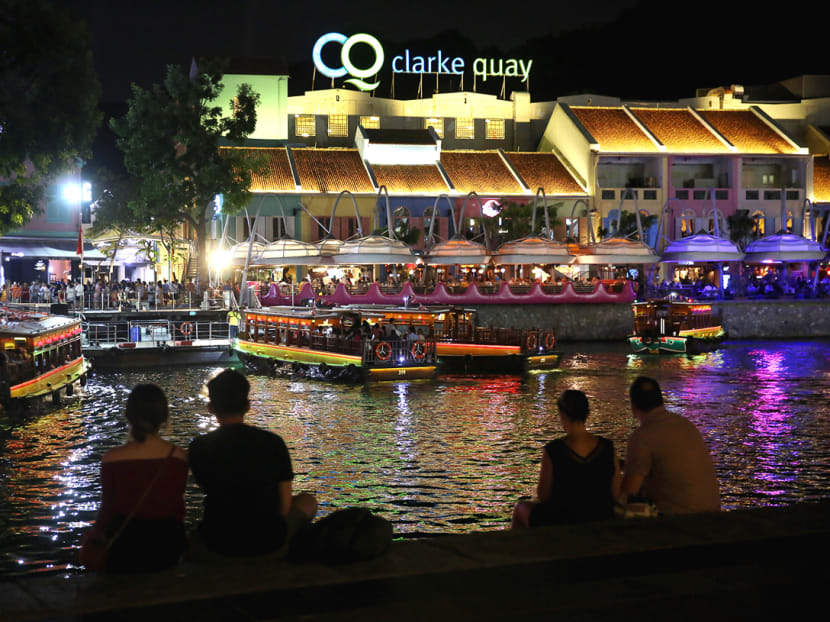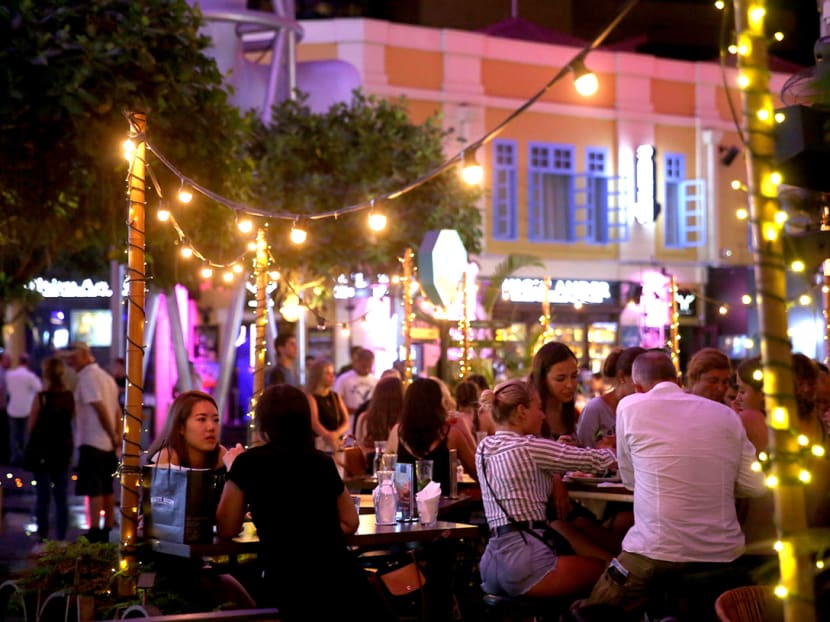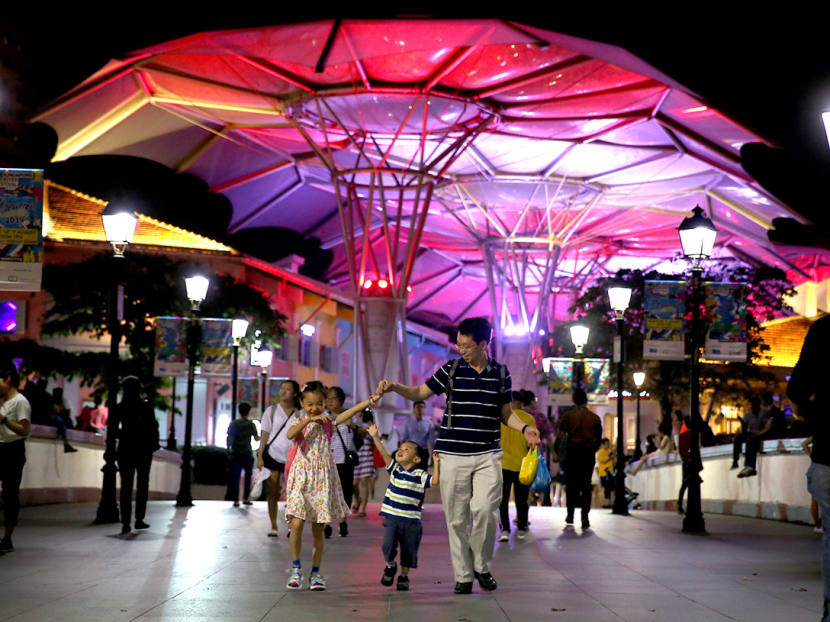The Big Read: Bearing few traces of its past, Clarke Quay’s decades-long search for an identity goes on
SINGAPORE — When dusk falls, the place comes alive — turning into a vibrant nightspot lined with pubs and clubs, as revellers spill over onto the streets and music blares in the background. But in the day, Clarke Quay plays host to cartoon character mascots and families with eager children in tow.

Clarke Quay’s image as a nightlife destination in Singapore was cemented following the completion of this exercise in 2006, which saw tenants moving into five blocks of restored 19th century shophouses and warehouses.
SINGAPORE — When dusk falls, the place comes alive — turning into a vibrant nightspot lined with pubs and clubs, as revellers spill over onto the streets and music blares in the background.
There is the odd flasher and fights occasionally break out, along with other unsavoury incidents commonly associated with partying spots everywhere.
But in the day, the place becomes much quieter — and more wholesome, playing host to cartoon character mascots like SpongeBob and Dora, as well as families with eager children in tow looking for a good time at the carnival games and Nickelodeon-themed festivals.
Welcome to the two worlds of Clarke Quay, different as night and day, amid efforts to widen the appeal of the area which has one of the highest concentrations of clubs and bars in the city-state.
Since 2012, about 1 million visitors go to Clarke Quay every month. In response to TODAY’s queries, Mr Adrian Lai, the centre manager for Clarke Quay, said: “Beyond catering to the night economy, Clarke Quay’s positioning as a must-visit destination for locals and tourists of all ages, day or night, is further reinforced with exciting family-friendly activities.”
In recent times, CapitaLand, which manages the site, has been bringing in a raft of wholesome and family-friendly activities. For example, the Singapore Festival of Fun, held during the March school holidays and meant to provide entertainment for the whole family, was first brought in three years ago. There is also a day-time carnival on the first Sunday of every month.

While the efforts seek to address Clark Quay’s daytime “ghost town” problem — and widen the historical site’s appeal beyond late night revellers — they have led some experts and tenants interviewed by TODAY to question the area’s schizophrenic identity.
Nevertheless, other experts and nightlife industry players believe there is much room to grow Clarke Quay’s daytime business, and segmenting the different customer groups by day and night is a feasible strategy — which could include paying greater homage to the area’s historical roots.
THE CHANGING FACES OF CLARKE QUAY
Clarke Quay was named after Sir Andrew Clarke, Governor of the Straits Settlements from November 1873 to May 1875. As one of the quays along the Singapore River, Clarke Quay’s history is inseparable from the early traders and coolies who plied the river in the 1800s, moving and transporting goods from boats to warehouses, some of which still stand today.
Due to its historical significance, Clarke Quay was gazetted as a heritage conservation district by the Urban Redevelopment Authority in 1989 and the area was opened for private development, according to the National Library Board’s web encyclopedia Infopedia.
DBS Land, which was one-half of the predecessor of CapitaLand, won the tender with a bid of S$54 million and Clarke Quay was reopened in 1993 with a family-friendly focus — boasting more than 170 retail shops, 17 food and beverage outlets and a S$25-million adventure ride that included heritage elements from the country’s past.
Some of its more iconic tenants in the 1990s were food stallholders from the Satay Club, who had to vacate their premises at the waterfront location earmarked to build what is known today as the Esplanade - Theatres on the Bay.
Unfortunately, the Clarke Quay project was not a commercial success, with an accumulated loss of S$4.42 million just a year after the re-opening, according to NLB’s Infopedia page.
The adventure ride closed in the mid-1990s. The number of visitors fell due to reasons such as the area's relative inaccessibility, the lack of shelter and the absence of a coherent identity with its eclectic mix of tenants.
In 2003, Clarke Quay underwent another S$80-million makeover after CapitaLand — which became the site’s manager following the merger of DBS Land and Pidemco — commissioned a British architectural firm to refresh the area’s image and infrastructure.
To give visitors a pleasant experience regardless of the weather, the makeover involved the construction of pod-like dining platforms and the installation of silent fans and overhead canopies along Clarke Quay’s main walkways.
Moving away from the family-oriented positioning, new tenants including French cabaret Crazy Horse and nightclubs such as Attica and Ministry of Sound were brought in.

Clarke Quay’s image as a nightlife destination in Singapore was cemented following the completion of this exercise in 2006, which saw tenants moving into five blocks of restored 19th century shophouses and warehouses.
In its heyday, Clarke Quay was one of the top nightlife destinations in Asia, if not the world, said industry veteran Dennis Foo, who used to own now-defunct nightclubs St James Power Station and Shanghai Dolly.
Shanghai Dolly was located in Clarke Quay, before it closed in April last year.
“At the height of it, (Clarke Quay) was the envy of many cities in the region. Everyone was trying to emulate (it),” said Mr Foo.
Despite the success of Clarke Quay, the nature of the nightlife business — where customers are always looking for the next big thing — meant that many pubs and clubs in the area have come and gone, including high-profile ones such as Crazy Horse, Ministry of Sound and Zirca.
One of the most popular nightclubs in Singapore, Zouk, has taken over the tenancy of the space previously occupied by the Ministry of Sound and Zirca.
Over the years, eateries such as Hai Di Lao, Motorino and Prive have also moved in. Some of Clarke Quay’s latest tenants include family-friendly F&B outlets such as Holey Moley, a mini golf club and bar; Hong Kong cafe Tsui Wah; and bubble tea store HeyTea.
Clarke Quay is among the riverside areas that are being managed by Singapore River One (SRO). A private sector-led initiative, SRO was set up in 2012 to drive initiatives that benefit the Singapore River precinct, which includes Boat Quay, Clarke Quay and Robertson Quay.
In 2017, the areas managed by SRO was officially designated as Singapore's first Business Improvement District in 2017 as part of a pilot scheme, which now includes nine other precincts, including Marina Bay and Kampong Glam.
Responding to TODAY’s queries, SRO said Clarke Quay has always positioned itself as a "destination for good food and entertainment". "Some of the restaurants do open for lunch so it is good for the office crowd working around the area. Food brings everybody together so families are welcome too," said an SRO spokesperson.
MIXED PICTURE FOR BUSINESSES
Tenants interviewed said that from their observations, about three to four tenants move out every year on average, with new ones coming in. This could be partly attributed to the harsh business environment for nightlife establishments in particular.
Nevertheless, existing tenants gave a mixed picture of how their business is doing.

Some, such as Le Noir, Bayang and Harry’s, said that their business was generally fine. But others such as The Connoisseur Concerto (TCC), Prive and Highlander said that sales have gone down compared with last year.
They cited various reasons: The uncertain economic outlook, the tightening of alcohol licensing hours, the slump in the oil and gas industry which substantially accounts for Clarke Quay’s clientele, as well as competition from F&B outlets and nightspots elsewhere.
“It’s very hard to keep business here,” said Ms Lui Concina, manager of bar and restaurant Highlander.
Before regulatory changes were introduced in 2013, most establishments in Clarke Quay could sell alcohol until 6am. The new licensing restrictions mean that most can sell only until 3am on most days.
“The biggest problem is the alcohol ban. A lot of places used to operate later at Clarke Quay,” said Mr Cedric Siah, assistant manager at Prive’s Clarke Quay outlet.
Mr Foo’s son, Gordon, who took over operations of Shanghai Dolly, had previously told the media that the nightclub’s closure was due to the new alcohol licensing restrictions.
Overall, tenants say the area continues to attract healthy crowds in the evenings, especially on Wednesday, Friday and Saturday.
THE DAYTIME PROBLEM
While there is much life at night in Clarke Quay, it is a totally different story in the day, with tenants complaining of poor footfall, even on weekends.
Some tourists whom TODAY spoke to described daytime Clarke Quay as “empty”, “quiet”, and even “creepy”.
Lamenting that business this year has been “challenging”, the outlet manager of TCC, who only wanted to be known as Mr Ogie, said that it “seldom” gets customers in the day.
The lack of crowds in the daytime also means that some tenants do not see much point in doing business in the day.
“No one comes here in the day. You can extend (to cater to the day crowd) but at what operational cost to outlets? Am I going to open at 1pm or 2pm? No, our costs are already so high. Rental is high, manpower cost is high. It doesn’t make economic sense. Most of us won’t,” said a tenant who declined to be named.
Nevertheless, a few F&B outlets in Clarke Quay are offering special lunch-time promotions in a bid to draw more customers before dark.
A spokesperson for Tsui Wah said the cafe has a “consistent footfall of customers throughout the day”, with its weekday set lunch that costs S$25 for two people being “well-received among the working crowd”.
Hutong, which serves traditional Northern Chinese cuisine, offers a three-course set lunch at about S$15, while American restaurant chain Hooters is selling its set lunch at about S$10.
About two weeks ago, Rodizio Do Brazil moved up its opening hours from 6pm to noon. Its main draw? A S$15 set lunch, which includes a starter, a main course, a dessert and a drink. Its operations manager Shawn Loh told TODAY that the restaurant is still testing the viability of longer opening hours but he noted that there is “not much traffic”, except for the few tourists stopping by to take a break from the blazing sun.
Mr Loh said he also tries to chat and build rapport with customers in the day, hoping that they might patronise the place again in the evening.
EXPERTS DIVIDED ON GOING THE FAMILY-FRIENDLY ROUTE
While CapitaLand’s strategy to bring in more family-friendly activities would help to improve business in the day, some experts felt that this could backfire and dilute Clarke Quay’s well-established nightlife branding.
Mr Kevin Wee, senior tourism lecturer at Nanyang Polytechnic, said the family segment should be Clarke Quay’s secondary target customers. While it should continue to bring in family-friendly events on an ad hoc basis, these should not be permanent features, he added.
“If they want to get extra money in the daytime, then don’t push it too hard. If (they) push too hard, it might start changing the tenant mix, and this might affect the nightlife (business),” said Mr Wee.
He added: “Clarke Quay has to make a clear decision as to whether it should stay primarily as a nightspot. If they do, then don’t change too much, it might mess up what’s working now.”
In any case, some experts pointed out that despite the best efforts, there are limits to Clarke Quay’s allure as a family-friendly destination.

Mr Wee said: “They need something of sufficient quality to make (families) want to go all the way to Clarke Quay, which besides F&B, is irrelevant for families.”
Ms Steffi Oh, a business lecturer at Singapore Polytechnic, noted that Clarke Quay’s current slate of family-friendly events, such as the annual Singapore Festival of Fun, would not be able to draw crowds there on a longer-term basis.
Moreover, there are already plenty of family-friendly attractions in Singapore, such as the Singapore Zoo, Gardens By The Bay or the Botanic Gardens, said some experts, who questioned what Clarke Quay can offer to compete against these places.
“I don’t think that trying to make it family-friendly is going to make a difference,” said Mr Benjamin Cassim, manager of Temasek Polytechnic’s hospitality and tourism diploma programme.
Still, other experts pointed out that there are places in other countries which have successfully blended family-friendly and nightlife offerings.
For example, the Sydney Harbour in Australia is lined with several drinking establishments but many families can be spotted walking along the harbour to enjoy the view of the Sydney Opera House, said Ngee Ann Polytechnic’s tourism lecturer Michael Chiam.
Some experts and industry players said it is about getting the right mix of tenants and programmes, as well as separating the different crowds to avoid a clash of images which Clarke Quay is trying to portray.
Mr Chiam believes that Clarke Quay can leverage its rich history in order to attract families with young children.
“(In the daytime), parents can bring children there to explain Singapore’s history. At night, the partygoers come for a different purpose,” he said.
Mr Foo said the family segment would provide a much-needed boost to the area’s F&B outlets, beyond catering to late night revellers.
“F&B today is competitive, the cost of operations is not low… night business alone is not a strong enough proposition. Day component comes to play,” he added.
Whether Clarke Quay can succeed in pulling in the family segment would also depend on its image as a nightlife hotspot.
While some observers felt that the area has developed a bit of a seedy reputation, others including Mr Foo disagreed.
Mr Foo reiterated: “There is no sleaze (at Clarke Quay). It makes a lot of difference. If there is sleaze, families won’t come.”
WHAT TENANTS HOPE TO SEE
Several tenants whom TODAY spoke to were unconvinced by CapitaLand’s to widen the appeal to families.
“To me, it doesn’t make sense,” said Mr Ogie of TCC.
Some tenants said they hope to see more events organised for the nightlife crowd, such as concerts or parties on the river.
“It’s not going to work if you don’t have the tenants to come in and help. And most tenants (at Clarke Quay) are geared towards nightlife… If you're good at nightlife and that’s what you're known for, stick to it,” said the tenant who wished to remain anonymous.
In response to the tenants’ concerns, Mr Lai — the centre manager for Clarke Quay — stressed that the area’s marketing efforts are “predominantly geared towards profiling its exciting nightlife, entertainment and F&B offerings”.
“The remainders are daytime family-friendly events and promotions that serve crowds who patronise Clarke Quay in the day,” he said.
MAKING CLARKE QUAY GREAT AGAIN
Even as Clarke Quay seeks to woo a different segment of visitors, some nightlife industry veterans believe that the area has lost its shine as Singapore’s top nightlife destination amid stiff competition from Marina Bay Sands (MBS) in particular.
In the face of licensing restrictions and competition from other nightlife establishments, Clarke Quay’s reputation is “a shade off its heyday”, said Mr Foo.
He suggested that tenants should work with the landlord to enhance the area’s safety and security. This could then give the authorities greater confidence in easing the alcohol licensing restrictions, he added.
While Clarke Quay still has “a lot of growth potential”, the journey back to the top will be quite “tough”, said Mr Andrew Ing, chief operating officer of hospitality company Lo and Behold and former marketing manager of Zouk.
“I don’t think it’s going to be easy but it is worth a try,” said Mr Ing.
With the recent opening of Marquee at MBS, operators at Clarke Quay need to raise their game with “good ideas, good entertainment and good training for staff” in the face of tough competition, he added.











